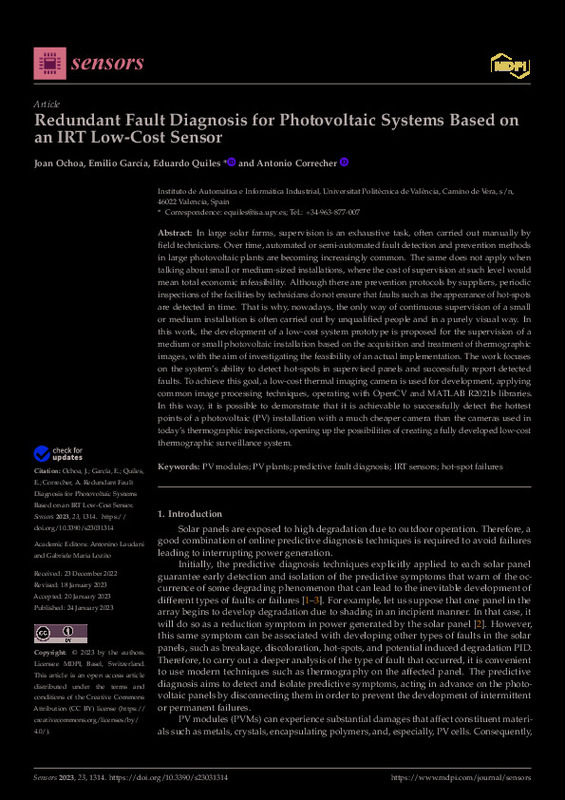JavaScript is disabled for your browser. Some features of this site may not work without it.
Buscar en RiuNet
Listar
Mi cuenta
Estadísticas
Ayuda RiuNet
Admin. UPV
Redundant Fault Diagnosis for Photovoltaic Systems Based on an IRT Low-Cost Sensor
Mostrar el registro sencillo del ítem
Ficheros en el ítem
| dc.contributor.author | Ochoa, Joan
|
es_ES |
| dc.contributor.author | García Moreno, Emilio
|
es_ES |
| dc.contributor.author | Quiles Cucarella, Eduardo
|
es_ES |
| dc.contributor.author | Correcher Salvador, Antonio
|
es_ES |
| dc.date.accessioned | 2023-03-29T18:01:00Z | |
| dc.date.available | 2023-03-29T18:01:00Z | |
| dc.date.issued | 2023-02 | es_ES |
| dc.identifier.uri | http://hdl.handle.net/10251/192648 | |
| dc.description.abstract | [EN] In large solar farms, supervision is an exhaustive task, often carried out manually by field technicians. Over time, automated or semi-automated fault detection and prevention methods in large photovoltaic plants are becoming increasingly common. The same does not apply when talking about small or medium-sized installations, where the cost of supervision at such level would mean total economic infeasibility. Although there are prevention protocols by suppliers, periodic inspections of the facilities by technicians do not ensure that faults such as the appearance of hot-spots are detected in time. That is why, nowadays, the only way of continuous supervision of a small or medium installation is often carried out by unqualified people and in a purely visual way. In this work, the development of a low-cost system prototype is proposed for the supervision of a medium or small photovoltaic installation based on the acquisition and treatment of thermographic images, with the aim of investigating the feasibility of an actual implementation. The work focuses on the system's ability to detect hot-spots in supervised panels and successfully report detected faults. To achieve this goal, a low-cost thermal imaging camera is used for development, applying common image processing techniques, operating with OpenCV and MATLAB R2021b libraries. In this way, it is possible to demonstrate that it is achievable to successfully detect the hottest points of a photovoltaic (PV) installation with a much cheaper camera than the cameras used in today's thermographic inspections, opening up the possibilities of creating a fully developed low-cost thermographic surveillance system. | es_ES |
| dc.language | Inglés | es_ES |
| dc.publisher | MDPI AG | es_ES |
| dc.relation.ispartof | Sensors | es_ES |
| dc.rights | Reconocimiento (by) | es_ES |
| dc.subject | PV modules | es_ES |
| dc.subject | PV plants | es_ES |
| dc.subject | Predictive fault diagnosis | es_ES |
| dc.subject | IRT sensors | es_ES |
| dc.subject | Hot-spot failures | es_ES |
| dc.subject.classification | INGENIERIA DE SISTEMAS Y AUTOMATICA | es_ES |
| dc.title | Redundant Fault Diagnosis for Photovoltaic Systems Based on an IRT Low-Cost Sensor | es_ES |
| dc.type | Artículo | es_ES |
| dc.identifier.doi | 10.3390/s23031314 | es_ES |
| dc.rights.accessRights | Abierto | es_ES |
| dc.contributor.affiliation | Universitat Politècnica de València. Escuela Técnica Superior de Ingeniería del Diseño - Escola Tècnica Superior d'Enginyeria del Disseny | es_ES |
| dc.contributor.affiliation | Universitat Politècnica de València. Escuela Técnica Superior de Ingenieros Industriales - Escola Tècnica Superior d'Enginyers Industrials | es_ES |
| dc.description.bibliographicCitation | Ochoa, J.; García Moreno, E.; Quiles Cucarella, E.; Correcher Salvador, A. (2023). Redundant Fault Diagnosis for Photovoltaic Systems Based on an IRT Low-Cost Sensor. Sensors. 23(3):1-29. https://doi.org/10.3390/s23031314 | es_ES |
| dc.description.accrualMethod | S | es_ES |
| dc.relation.publisherversion | https://doi.org/10.3390/s23031314 | es_ES |
| dc.description.upvformatpinicio | 1 | es_ES |
| dc.description.upvformatpfin | 29 | es_ES |
| dc.type.version | info:eu-repo/semantics/publishedVersion | es_ES |
| dc.description.volume | 23 | es_ES |
| dc.description.issue | 3 | es_ES |
| dc.identifier.eissn | 1424-8220 | es_ES |
| dc.identifier.pmid | 36772354 | es_ES |
| dc.identifier.pmcid | PMC9920220 | es_ES |
| dc.relation.pasarela | S\481678 | es_ES |
| dc.subject.ods | 07.- Asegurar el acceso a energías asequibles, fiables, sostenibles y modernas para todos | es_ES |








